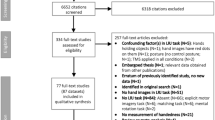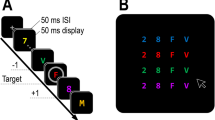Abstract
Previous investigations have uncovered a strong visual bias toward the index finger when reaching and grasping stationary or horizontally moving targets. The present research sought to explore whether the index finger or thumb would serve as a significant focus for gaze in tasks involving vertically translating targets. Participants executed right-handed reach-to-grasp movements towards upward or downward moving 2-D targets on a computer screen. When the target first appeared, participants made anticipatory fixations in the direction of the eventual movement path (i.e. well above upwardly moving targets or well below downwardly moving targets) and upon movement onset, fixations shifted toward the leading edge of the target. For upward moving targets, fixations remained toward the leading edge upon reach onset, whereas for downward moving targets, fixations shifted toward the centre of the target. The same central fixation location was observed at the time of grasp for all targets. Furthermore, for downwardly moving targets, the placement of the thumb appears to have influenced fixation location in conjunction with, not replacement of, the influence of the index finger. These findings are indicative of the increasingly relevant role of the thumb in mediating reaching and grasping downwardly moving targets.


Similar content being viewed by others
References
Bowers D, Heilman KM (1980) Pseudoneglect: Effects of hemispace on a tactile line bisection task. Neuropsychologia 18:491–498. https://doi.org/10.1016/0028-3932(80)90151-7
Brogaard B (2011) Conscious vision for action versus unconscious vision for action? Cogn Sci 35(6):1076–1104. https://doi.org/10.1111/j.1551-6709.2011.01171.x
Brouwer AM, Franz VH, Gegenfurtner KR (2009) Differences in fixations between grasping and viewing objects. J Vision 9(1):1–24. https://doi.org/10.1167/9.1.18
Bulloch MC, Prime SL, Marotta JJ (2015) Anticipatory gaze strategies when grasping moving objects. Experim Brain Res 233(12):3413–3423. https://doi.org/10.1007/s00221-015-4413-7
Cavina-Pratesi C, Hesse C (2013) Why do the eyes prefer the index finger? Simultaneous recording of eye and hand movements during precision grasping. J Vision 13(5):1–15. https://doi.org/10.1167/13.5.15
De Brouwer S, Yuksel D, Blohm G, Missal M, Lefèvre P (2002) What triggers catch-up saccades during visual tracking? J Neurophysiol 87(3):1646–1650. https://doi.org/10.1152/jn.00432.2001
Desanghere L, Marotta JJ (2011) “Graspability” of objects affects gaze patterns during perception and action tasks. Experim Brain Res 212(2):177–187. https://doi.org/10.1007/s00221-011-2716-x
Galea MP, Castiello U, Dalwood N (2001) Thumb invariance during prehension movement: Effects of object orientation. NeuroReport 12(10):2185–2187. https://doi.org/10.1097/00001756-200107200-00028
Jewell G, McCourt ME (2000) Pseudoneglect: A review and meta-analysis of performance factors in line bisection tasks. Neuropsychologia 38(1):93–110. https://doi.org/10.1016/s0028-3932(99)00045-7
Johansson RS, Westling G, Bäckström A, Flanagan JR (2001) Eye-hand coordination in object manipulation. J Neurosci 21(17): 6917–6932. Retrieved from http://www.jneurosci.org.uml.idm.oclc.org/content/21/17/6917
Langridge RW, Marotta JJ (2017) Grasping occluded targets: Investigating the influence of target visibility, allocentric cue presence, and direction of motion on gaze and grasp accuracy. Experim Brain Res 235(9):2705–2716. https://doi.org/10.1007/s00221-017-5004-6
Marotta JJ, Graham TJ (2016) Cluttered environments: Differential effects of obstacle position on grasp and gaze locations. Canad J Experim Psychol 70(3):242–247. https://doi.org/10.1037/cep0000079
Massen C, Rieger M, Sülzenbrück S (2014) Using scissors to bisect a line: A perception-action dissociation in complex tool use. Atten Percep Psychophys 76:172–178. https://doi.org/10.3758/s13414-013-0564-4
Melmoth DR, Grant S (2012) Getting a grip: Different actions and visual guidance of the thumb and finger in precision grasping. Experim Brain Res 222(3):265–276. https://doi.org/10.1007/s00221-012-3214-5
Milner AD, Goodale MA (2008) Two visual systems re-viewed. Neuropsychologia 46(3):774–785. https://doi.org/10.1016/j.neuropsychologia.2007.10.005
Oldfield RC (1971) The assessment and analysis of handedness: The Edinburgh inventory. Neuropsychologia 9(1):97–113
Prime SL, Marotta JJ (2013) Gaze strategies during visually-guided versus memory-guided grasping. Experim Brain Res 225(2):291–305. https://doi.org/10.1007/s00221-012-3358-3
Polanen VV, Davare M (2015) Interactions between dorsal and ventral streams for controlling skilled grasp. Neuropsychologia 79:186–191. https://doi.org/10.1016/j.neuropsychologia.2015.07.010
Salvucci D, Goldberg JH (2000) Identifying fixations and saccades in eye-tracking protocols. Proc Eye Track Res Appl Sympos
Volcic R, Domini F (2016) On-line visual control of grasping movements. Experim Brain Res 234(8):2165–2177. https://doi.org/10.1007/s00221-016-4620-x
Voudouris D, Smeets JBJ, Brenner E (2016) Fixation biases towards the index finger in almost-natural grasping. Public Library Sci 1(1):1–29. https://doi.org/10.1371/journal.pone.0146864
Voudouris D, Brenner E, Schot WD, Smeets JBJ (2010) Does planning a different trajectory influence the choice of grasping points? Experim Brain Res 206(1):15–24. https://doi.org/10.1007/s00221-010-2382-4
Acknowledgements
This research was supported by the Natural Science and Engineering Research Council of Canada (NSERC) with an Undergraduate Student Research Award (MRT) and a Discovery grant (JJM).
Author information
Authors and Affiliations
Corresponding author
Ethics declarations
Conflict of interest
The authors declare that they have no conflict of interest.
Ethical standards
All procedures performed in studies involving human participants were in accordance with the ethical standards of the institutional and/or national research committee and with the 1964 Helsinki declaration and its later amendments or comparable ethical standards. Raw data are available athttps://doi.org/10.5203/FK2/XHCNXE.
Additional information
Communicated by Melvyn A. Goodale.
Publisher's Note
Springer Nature remains neutral with regard to jurisdictional claims in published maps and institutional affiliations.
Rights and permissions
About this article
Cite this article
Thulasiram, M.R., Langridge, R.W., Abbas, H.H. et al. Eye–hand coordination in reaching and grasping vertically moving targets. Exp Brain Res 238, 1433–1440 (2020). https://doi.org/10.1007/s00221-020-05826-7
Received:
Accepted:
Published:
Issue Date:
DOI: https://doi.org/10.1007/s00221-020-05826-7




